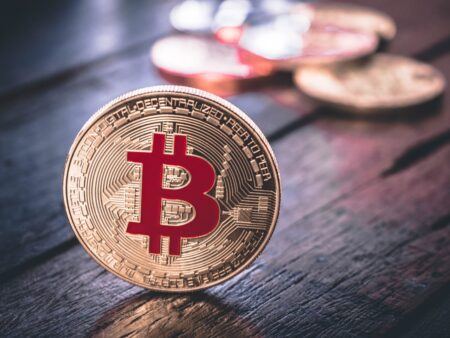Despite the recent crypto crackdown in China, on Saturday (November 23), the price of Bitcoin is managing to stay above the $7,000 level, up over 4% since it reached $6,878 at 14:00 UTC on the day before.
According to data from CryptoCompare, Bitcoin started yesterday (November 22) at $7,688, fell to $7,100 by 10:00 UTC, and by 14:00, the BTC price had reached $6,878, a level last seen back in May.
However, since then, the Bitcoin price has managed to go up 4.18% to $7,166, where it is at the time of writing (around 10:10 UTC on November 23):

Although Bitcoin is down 44.5% since June 26 when it reached its all-time-high (ATH) for this year of $12,913 and that it might appear to some more pessimistic crypto traders that the sky is falling down, it is worth remembering that, against USD, Bitcoin is still up 84.69% in the year-to-date (YTD) period and up 66.65% compared to where it was a year ago.
We can’t blame the entire fall in the price of Bitcoin from $12,913 to $7,166 where it is today on China. After all, on October 23, the day before Chinese President Xi Jinping gave his now famous pro-blockchain speech, Bitcoin was trading around $7,479.
According to a report by China’s Xinhua News Agency (the official state-run press agency of the People’s Republic of China), which was published around 10:15 UTC on October 25, the Political Bureau of the Central Committee of the Communist Party of China (CPC) completed the “18th collective study” on blockchain technology on the afternoon of October 24.
China’s President Xi Jinping, who is also the general secretary of the Central Committee of the CPC, gave a speech that “emphasized that the integrated application of blockchain technology plays an important role in new technological innovation and industrial transformation.”
Per the Xinhua News Agency’s report:
“He pointed out that the application of blockchain technology has extended to digital finance, Internet of Things, intelligent manufacturing, supply chain management, digital asset trading and other fields. At present, major countries in the world are accelerating the development of blockchain technology. China has a good foundation in the field of blockchain. It is necessary to accelerate the development of blockchain technology and industrial innovation, and actively promote the development of blockchain and economic and social integration.”
Although President Xi’s remarks were specifically about blockchain technology and not decentralized cryptocurrencies such as Bitcoin, the following day, after reports about the speech were released to Chinese media (and thereafter, widely covered elsewhere), some crypto traders around the world mistakenly took this as a sign that the Chinese government was fully behind blockchain and crypto. This helped the Bitcoin price go up 29.38% from $7,479 on October 23 to $9,677 on October 27.
Then, on November 15, when Bitcoin was trading around $8,479, we found out that the Weibo accounts of both Binance and TRON had gotten blocked.
According to a report by Coindesk published later that day, the Shanghai Internet Finance Rectification Agency and the Shanghai Bureau of the People’s Bank of China had posted a notice on Weibo that said “regulators in each district of Shanghai must search and inspect local crypto exchange-related services before Nov. 22 and report to the central bank for further actions.”
A few days later (on November 18), China Central Television (CCTV), the main state television broadcaster in mainland China, aired an episode (titled ‘Blockchain Is Not an ATM’) of Focus Report (an important news program that is kind of similar to “60 Minutes” in the U.S.) that focused on blockchain technology and cryptocurrencies.
According to CCTV’s episode transcript, although blockchain technology has “great value in the fields of trade finance, public services, and traceability of agricultural products,” the “blockchain boom” has also caused some “chaos in the society.”
Wu Zhen, the Head of the Key Laboratory of Internet Financial Security Technology of the National Internet Emergency Center, had this to say:
“At present, we have detected the blockchain company with the word “blockchain” or its business scope. There are more than 32,000 blockchains, and the number is still relatively large. However, after actual monitoring, we found that there are actually not many companies that have blockchain technology or chain ownership. This is probably the same amount. About 10%, or even less than 10%.”
This episode focused mostly on the various blockchain/crypto scam operations that have been going on in China. However, importantly, it also reminded people that on 4 September 2017, “the People’s Bank of China and other seven ministries issued an announcement clearly stating that the so-called ‘virtual currency’ is essentially an unauthorised illegal public financing, suspected of illegally selling tokens and illegally issuing securities.”
On November 23, the Shanghai office of China’s central bank, the People’s Bank of China (PBC), posted an announcement on its website; this contained the same information that had been on the leaked copy of announcement, which had been posted to Weibo on November 15.
More specifically the Shanghai branch of the PBOC described an plan for inspecting crypto trading operations in every district of the city. It also reminded people to report to authorities any evidence of “activities and operations related to virtual currencies in any form.” Furthermore, it asked people to report any person or organization using services based out of China for trading virtual currencies or launching ICOs.
This was the first major crackdown on ICOs and crypto trading since September 2017.
Dovey Wan, a Founding Partner of blockchain-focused venture investment firm Primitive Ventures, said on Twitter on November 22 that she expected the material effects of this second crypto crackdown to be less than those of the first crypto crackdown:
In 2017 when similar announcement is made, BTCC and Yunbi got shut down but this time
1. They can’t shut down Binance
2. Huobi and Okex are regulatory “vaccinated”
3. Derivatives ex like Bitmex is more liquid than spotSo the material impact will be much less than 9/4 2017 pic.twitter.com/NGzfI9aY3J
— Dovey 以德服人 Wan 🗝 🦖 (@DoveyWan) November 22, 2019
Featured Image Credit: Photo via Pexels.com









